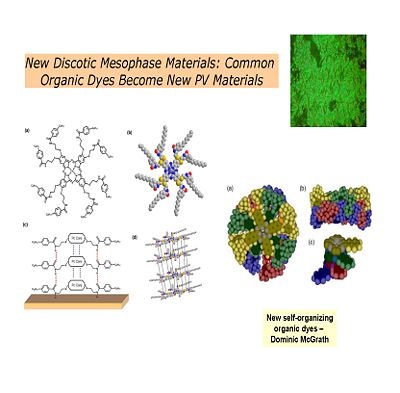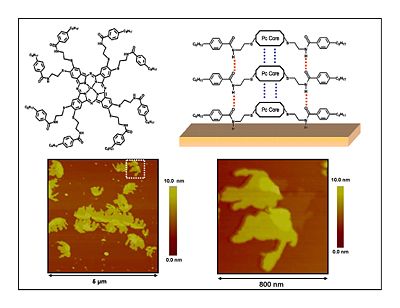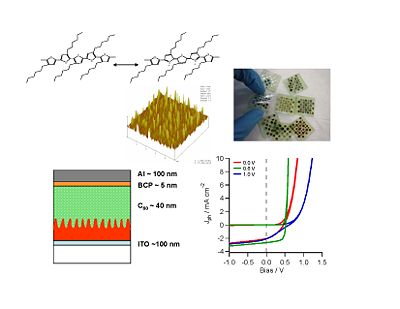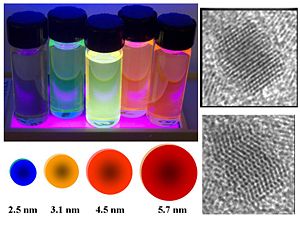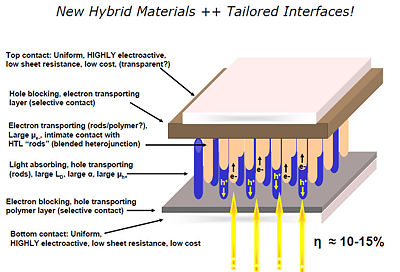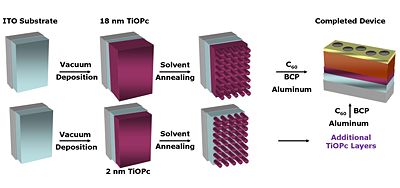Difference between revisions of "Current OPV Research Directions"
Cmditradmin (talk | contribs) m (→New materials) |
Cmditradmin (talk | contribs) m (→Nanoparticles) |
||
| Line 100: | Line 100: | ||
=== Nanoparticles === | === Nanoparticles === | ||
[[Image:Dyes_color.jpg|thumb|300px|Quantum dot compounds can be can be used as part of the donor or acceptor materials.]] | |||
[[Image:semicon_nanoparticle.jpg|thumb|left|400px|Semiconductor nanoparticles built from cadmium selenide 2-5nm in diameter take on interesting electron properties. The particle is capped with ligands to make them processable. The size of the nanoparticle determines the luminescence. The smallest make blue color, the largest makes the red. Used in a solar cell they absorb in the same color ranges.]] | [[Image:semicon_nanoparticle.jpg|thumb|left|400px|Semiconductor nanoparticles built from cadmium selenide 2-5nm in diameter take on interesting electron properties. The particle is capped with ligands to make them processable. The size of the nanoparticle determines the luminescence. The smallest make blue color, the largest makes the red. Used in a solar cell they absorb in the same color ranges.]] | ||
<br clear='all'> | <br clear='all'> | ||
Revision as of 10:30, 3 September 2009
| Previous Topic | Return to OPV Menu |
These are promising directions in organic photovoltaic research being pursued at the CMDITR
Evolution of Solar Cell Efficiency
These are the types of efficiencies that people have been able to reach. For example, with silicon, fill factors of about 0.8 and conversion efficiency, of 24% can be reached.
The Grätzel cell, which is a hybrid cell that has both organic and inorganic components and uses a liquid electronlyge, has a conversion efficiency of about 11%. Michael Grätzel is a professor at the technical school of Lausanne in Switzerland.
With polymers, Allen Heeger has recently reported a conversion efficiency of up to 6%. Our goal at this time is to reach the 10% efficiency in organic cells. However, it does not seem to be very easy to achieve.
| Characteristic | Silicon | Organic (Tang) | Organic (Forrest) | Organic (Graetzel) | Polymer | Hybrid nanorods |
|---|---|---|---|---|---|---|
| Open circuit voltage (Voc; V) | 0.7 | 0.45 | 1.02 | 0.721 | 0.63 | 0.7 |
| Short circuit current density (Jsc; mA/cm2) | 43 | 2.3 | 9.7 | 20.53 | 9.5 | 5.7 |
| Voc x Jsc (mW/cm2) | 30.1 | 1.035 | 9.894 | 14.80213 | 5.985 | 3.99 |
| Fill factor (FF) | 0.8 | 0.65 | 0.59 | 0.704 | 0.68 | 0.4 |
| Illumination intensity (mW/cm2) | 100 | 75 | 100 | 100 | 80 | 96.4 |
| Conversion efficiency (%) | 24.08 | 0.9 | 5.7 | 10.4 | 5.1 | 1.7 |
New materials
Research directions include using multilayers of small molecules, building polymer blends with interpenetrated networks, nanostructured oxide polymers and hybird approaches using doped inorganics in an organic matrix.
Discotic Mesophase Materials
Dendritic Polymers
Nanoparticles
Tailored interfaces
Fabrication Processes
| Previous Topic | Return to OPV Menu |
